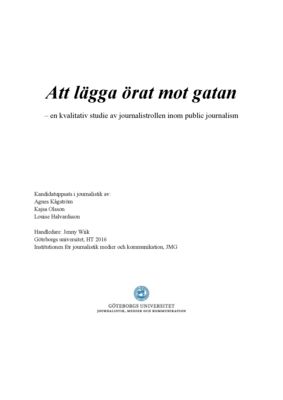Att lägga örat mot gatan
en kvalitativ studie av journalistrollen inom public journalism
This is a comparative case study that looks at public journalism as an ideal in a Swedish context, and how this ideal affects the journalist role. Public journalism is defined as an ideal where the agenda of the public is dominant and where the ordinary citizen is allowed more space in the news compared to traditional journalism. This should not be confused with citizen journalism where the public produces content independently and outside of the
established newsrooms. Public journalism was developed in the U.S. in the 1980s and the idea was to make the citizens engage in society – first and foremost by voting as the interest in politics was generally low at the time. In other areas public journalism was used to increase the social status of socioeconomically deprived areas. In Sweden several newsrooms have tried out public journalism as a method, but not always on a conscious level. However, there’s one exception, and that’s the free local newspaper Södra Sidan in Stockholm. They started as a reaction to the fact that other media didn’t cover what happened in the suburbs of Stockholm in a nuanced way. Very little research has been done on the topic of public journalism in Sweden, therefore our aim was to look at the role of the journalist within this context. Specifically we have studied how the journalists view public journalism in relation to their professional ideals, what challenges they experience and how they relate to the citizens.
This study examines two different publications: Södra Sidan and GöteborgDirekt. Both are owned by the same newspaper group, DirektPress. But while the journalists at Södra Sidan has public journalism as a consciously underlying ideal in their work, the journalists at GöteborgDirekt hasn’t. We were keen to examine if, and how, this ideal affected the
journalist role. In depth-interviews were made with journalists at Södra Sidan and GöteborgDirekt. To analyse our material we used the theory of professional discourse combined with democratic models based on the philosophy of Habermas.
Our result shows that due to a lack of resources on both papers, it was hard to fully live up to the intention of meeting the citizens outside of the office. But it was clear that the journalist role at Södra Sidan was in many ways different from the traditional journalist role.
We found that a dominant ideal for the journalists at Södra Sidan was to turn away from the traditional news reporting about crimes and politics, and instead let the citizens set the agenda for what topics to discuss. This could cause ethical dilemmas as it implies that they also need to consider people with anti-democratic values, such as citizens who neglect human rights of
refugees. At GöteborgDirekt the approach was more straightforward news reporting even though they also used some methods associated with public journalism in their work. But as the journalists at GöteborgDirekt did not view public journalism as a main ideal, the journalists remained more traditional in their journalist roles.
Nyckelord: public journalism, medborgarnära journalistik, lokala nyheter, medieskugga, deltagande, deliberativ demokrati, samtal, dialog, professionsteori, Södra Sidan, GöteborgDirekt, Habermas

